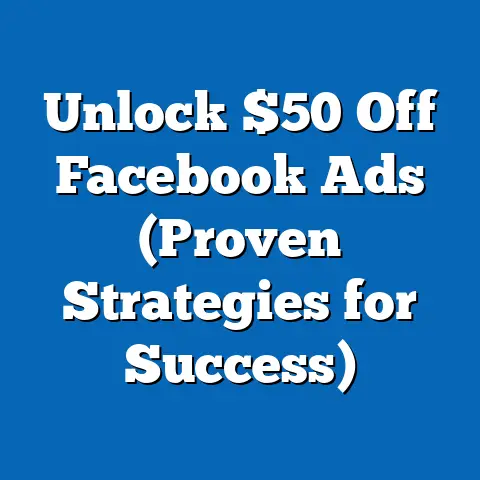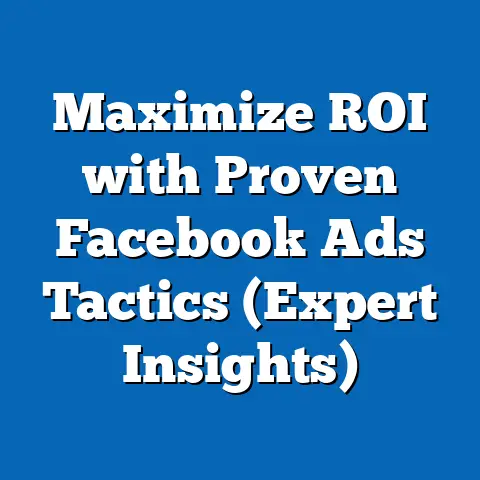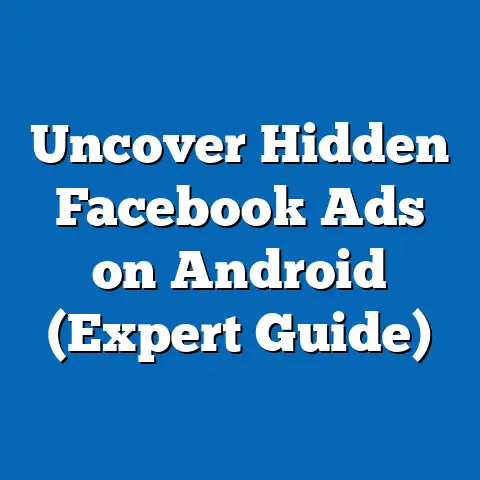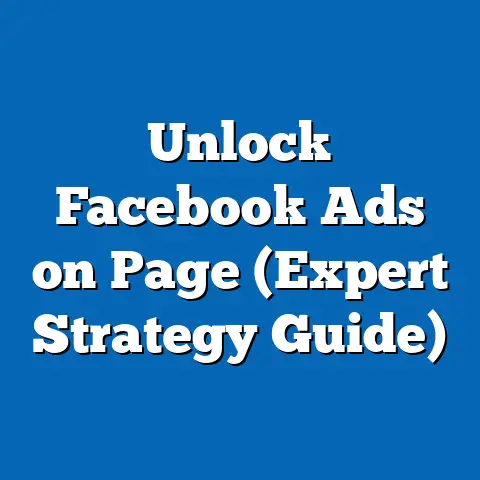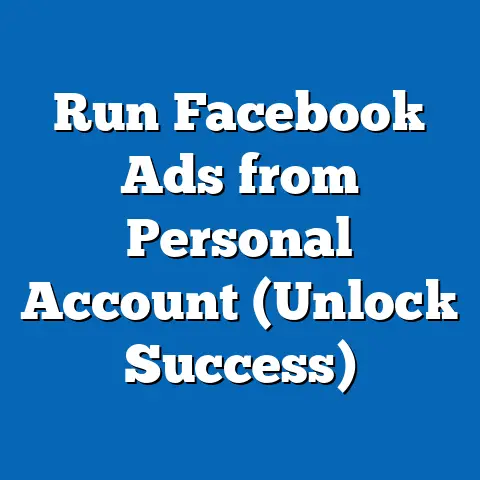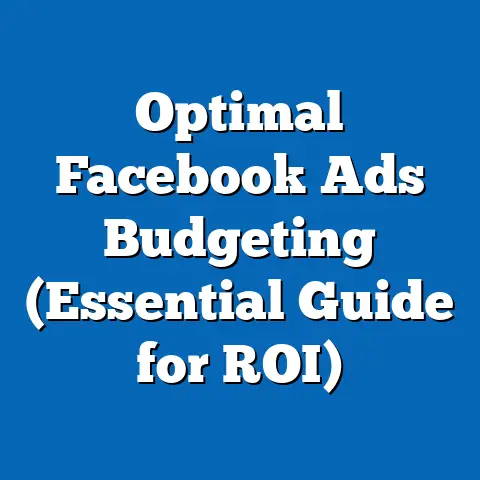Master Facebook Ads Goals (Proven Strategies Inside)
The digital landscape is in perpetual motion, a whirlwind of innovation fueled by relentless technological advancement. Think about it – just a decade ago, the idea of AI writing ad copy or algorithms predicting consumer behavior seemed like science fiction. Now, we’re living it. Artificial intelligence, machine learning, and big data analytics aren’t just buzzwords; they’re the engines driving the future of advertising, and Facebook Ads, now Meta Ads, is at the forefront.
These advancements have given us incredible tools: automated bidding strategies that optimize campaigns in real-time, hyper-targeted audience capabilities that pinpoint the perfect customer, and dynamic ad formats that personalize the shopping experience. But with all this power comes responsibility. You can’t just throw money at Facebook and hope for the best anymore. To thrive in this tech-driven environment, mastering Facebook Ads goals is paramount. Businesses must adapt, learn to leverage these tools effectively, and understand precisely what they want to achieve with every campaign.
I’ve seen firsthand how a well-defined goal can transform a struggling campaign into a roaring success. Conversely, I’ve also witnessed the frustration of businesses wasting their budgets because they lacked a clear objective. In this article, I’m going to share my insights and proven strategies to help you master Facebook Ads goals, turning your advertising efforts into a powerful engine for growth and engagement. Let’s dive in!
Understanding Facebook Ads Goals
Facebook Ads goals are the foundation of any successful advertising campaign. They are the specific, measurable objectives you want to achieve with your ads, acting as a roadmap to guide your strategy and measure your results. Think of them as the “why” behind your ad spend. Why are you running this campaign? What do you hope to accomplish?
Facebook offers a range of advertising goals, each designed to optimize your ads for a specific outcome. These goals are broadly categorized into three stages of the marketing funnel: Awareness, Consideration, and Conversion. Within these stages, you’ll find a variety of objectives, including:
- Awareness:
- Brand Awareness: Increase awareness of your brand among people most likely to pay attention.
- Reach: Show your ad to the maximum number of people within your target audience.
- Consideration:
- Traffic: Drive traffic to your website, app, or Facebook page.
- Engagement: Get more page likes, event responses, or post reactions, comments, and shares.
- App Installs: Encourage people to download your app.
- Video Views: Get more people to watch your video content.
- Lead Generation: Collect leads from people interested in your business or product.
- Messages: Start conversations with people on Messenger, WhatsApp, or Instagram Direct.
- Conversion:
- Conversions: Encourage valuable actions on your website, app, or in Messenger.
- Catalog Sales: Promote products from your e-commerce catalog.
- Store Traffic: Drive visits to your physical store locations.
- Brand Awareness: Increase awareness of your brand among people most likely to pay attention.
- Reach: Show your ad to the maximum number of people within your target audience.
- Traffic: Drive traffic to your website, app, or Facebook page.
- Engagement: Get more page likes, event responses, or post reactions, comments, and shares.
- App Installs: Encourage people to download your app.
- Video Views: Get more people to watch your video content.
- Lead Generation: Collect leads from people interested in your business or product.
- Messages: Start conversations with people on Messenger, WhatsApp, or Instagram Direct.
- Conversions: Encourage valuable actions on your website, app, or in Messenger.
- Catalog Sales: Promote products from your e-commerce catalog.
- Store Traffic: Drive visits to your physical store locations.
Choosing the right goal is critical because it tells Facebook’s algorithm what you want it to optimize for. For example, if you choose “Traffic,” Facebook will prioritize showing your ad to people who are most likely to click on it. If you choose “Conversions,” it will target users who are more likely to complete a purchase or other desired action.
I remember working with a local bakery that was struggling to get new customers. They were running Facebook ads, but their results were underwhelming. After reviewing their campaign, I realized they had chosen the “Engagement” goal, even though their primary objective was to increase sales. By switching to the “Conversions” goal and optimizing their ads for online orders, we saw a significant increase in sales within just a few weeks.
This highlights the importance of aligning your ads with specific, measurable goals. Setting clear objectives allows you to:
- Focus Your Efforts: Goals provide a clear direction for your campaign, helping you focus your resources and efforts on the most important aspects.
- Optimize Your Ads: By selecting the right goal, you tell Facebook’s algorithm how to optimize your ads for the desired outcome.
- Measure Your Success: Goals provide a benchmark for measuring the success of your campaign and identifying areas for improvement.
- Improve ROI: By focusing on specific, measurable goals, you can improve your return on investment and get more value from your advertising budget.
Studies have consistently shown that businesses with well-defined marketing goals achieve significantly better results than those without. According to a CoSchedule study, marketers who set goals are 376% more likely to report success. This statistic underscores the importance of starting with a clear objective before launching any Facebook Ads campaign.
Key Takeaway: Facebook Ads goals are the foundation of successful campaigns. Understanding the different types of goals and aligning them with your overall business objectives is crucial for achieving the desired results.
Aligning Business Objectives with Facebook Ads Goals
Now that you understand the different types of Facebook Ads goals, let’s discuss how to align them with your overarching business objectives. This is where the magic happens – when your advertising efforts directly support your business’s broader goals.
The key is to start with a clear understanding of your business objectives. What do you want to achieve as a company? Are you looking to increase revenue, expand market reach, build brand awareness, or something else? Once you have a clear understanding of your business objectives, you can then identify the Facebook Ads goals that will help you achieve them.
Here are some examples of how different business scenarios can align with specific Facebook Ads goals:
- Scenario 1: E-commerce Business Launching a New Product.
- Business Objective: Drive initial sales and generate awareness for the new product.
- Facebook Ads Goals:
- Conversions: Optimize ads for purchases of the new product.
- Traffic: Drive traffic to the product page on your website.
- Brand Awareness: Create ads that showcase the product’s features and benefits to a broad audience.
- Scenario 2: Local Restaurant Looking to Increase Foot Traffic.
- Business Objective: Attract more customers to the restaurant.
- Facebook Ads Goals:
- Store Traffic: Optimize ads for visits to your physical location.
- Engagement: Run ads with enticing food photos and special offers to encourage engagement and shares.
- Lead Generation: Collect email addresses for future promotions and discounts.
- Scenario 3: Software Company Looking to Generate Leads.
- Business Objective: Acquire qualified leads for their sales team.
- Facebook Ads Goals:
- Lead Generation: Use lead generation forms to collect contact information from interested prospects.
- Conversions: Drive traffic to a landing page with a compelling offer (e.g., free trial, demo) and optimize for sign-ups.
- Scenario 4: Non-Profit Organization Raising Awareness for a Cause.
- Business Objective: Increase awareness and support for their mission.
- Facebook Ads Goals:
- Brand Awareness: Reach a broad audience with ads that highlight the organization’s work and impact.
- Engagement: Encourage people to like, share, and comment on posts related to the cause.
- Conversions: Drive donations through targeted ads with a clear call to action.
- Business Objective: Drive initial sales and generate awareness for the new product.
- Facebook Ads Goals:
- Conversions: Optimize ads for purchases of the new product.
- Traffic: Drive traffic to the product page on your website.
- Brand Awareness: Create ads that showcase the product’s features and benefits to a broad audience.
- Conversions: Optimize ads for purchases of the new product.
- Traffic: Drive traffic to the product page on your website.
- Brand Awareness: Create ads that showcase the product’s features and benefits to a broad audience.
- Business Objective: Attract more customers to the restaurant.
- Facebook Ads Goals:
- Store Traffic: Optimize ads for visits to your physical location.
- Engagement: Run ads with enticing food photos and special offers to encourage engagement and shares.
- Lead Generation: Collect email addresses for future promotions and discounts.
- Store Traffic: Optimize ads for visits to your physical location.
- Engagement: Run ads with enticing food photos and special offers to encourage engagement and shares.
- Lead Generation: Collect email addresses for future promotions and discounts.
- Business Objective: Acquire qualified leads for their sales team.
- Facebook Ads Goals:
- Lead Generation: Use lead generation forms to collect contact information from interested prospects.
- Conversions: Drive traffic to a landing page with a compelling offer (e.g., free trial, demo) and optimize for sign-ups.
- Lead Generation: Use lead generation forms to collect contact information from interested prospects.
- Conversions: Drive traffic to a landing page with a compelling offer (e.g., free trial, demo) and optimize for sign-ups.
- Business Objective: Increase awareness and support for their mission.
- Facebook Ads Goals:
- Brand Awareness: Reach a broad audience with ads that highlight the organization’s work and impact.
- Engagement: Encourage people to like, share, and comment on posts related to the cause.
- Conversions: Drive donations through targeted ads with a clear call to action.
- Brand Awareness: Reach a broad audience with ads that highlight the organization’s work and impact.
- Engagement: Encourage people to like, share, and comment on posts related to the cause.
- Conversions: Drive donations through targeted ads with a clear call to action.
Understanding your target audience is equally important. Who are you trying to reach with your ads? What are their interests, demographics, and behaviors? The more you know about your target audience, the better you can tailor your ads and choose the right goals.
For example, if you’re targeting a younger audience, you might focus on engagement and video views, as they tend to be more active on social media and consume video content more frequently. If you’re targeting a more mature audience, you might focus on conversions and lead generation, as they are often more likely to make purchases or sign up for services online.
I once worked with a clothing boutique that was struggling to reach its target audience of young, fashion-conscious women. They were running generic ads with broad targeting, and their results were lackluster. By conducting thorough audience research and creating ads that resonated with their target demographic, we saw a significant increase in engagement and sales.
Key Takeaway: Aligning your business objectives with Facebook Ads goals requires a deep understanding of your business, your target audience, and the different types of goals available. By carefully considering these factors, you can create campaigns that are highly effective and drive measurable results.
Proven Strategies for Achieving Facebook Ads Goals
Now, let’s get into the nitty-gritty: the proven strategies for achieving each type of Facebook Ads goal. This is where you’ll learn how to turn your objectives into reality.
Brand Awareness: Make a Lasting Impression
The goal of brand awareness is to increase recognition and familiarity with your brand among your target audience. To achieve this, focus on creating visually appealing and memorable ads that tell a compelling story.
- Actionable Steps:
- Eye-Catching Visuals: Use high-quality images or videos that capture attention and showcase your brand’s personality.
- Storytelling: Craft a narrative that resonates with your audience and communicates your brand’s values.
- Consistent Branding: Ensure your ads are consistent with your brand’s visual identity (logo, colors, fonts).
- Targeted Reach: Use Facebook’s targeting options to reach people who are most likely to be interested in your brand.
- Real-World Example: Dove’s “Real Beauty” campaign is a classic example of successful brand awareness. Their ads feature real women of all shapes and sizes, promoting a message of body positivity and self-acceptance. This campaign resonated deeply with their target audience and significantly increased brand awareness.
- Eye-Catching Visuals: Use high-quality images or videos that capture attention and showcase your brand’s personality.
- Storytelling: Craft a narrative that resonates with your audience and communicates your brand’s values.
- Consistent Branding: Ensure your ads are consistent with your brand’s visual identity (logo, colors, fonts).
- Targeted Reach: Use Facebook’s targeting options to reach people who are most likely to be interested in your brand.
Lead Generation: Capture Qualified Prospects
Lead generation is all about collecting contact information from people who are interested in your business or product. To achieve this, you need to create a compelling lead magnet and optimize your landing pages for conversions.
- Actionable Steps:
- Compelling Lead Magnet: Offer something of value in exchange for contact information (e.g., ebook, free trial, discount code).
- Optimized Landing Pages: Create landing pages that are clear, concise, and easy to navigate.
- Lead Generation Forms: Use Facebook’s lead generation forms to collect contact information directly within the platform.
- Targeted Advertising: Target your ads to people who are most likely to be interested in your lead magnet.
- Real-World Example: HubSpot is a master of lead generation. They offer a wide range of free resources (e.g., ebooks, templates, checklists) in exchange for contact information. Their landing pages are optimized for conversions, and their ads are targeted to people who are interested in marketing and sales.
- Compelling Lead Magnet: Offer something of value in exchange for contact information (e.g., ebook, free trial, discount code).
- Optimized Landing Pages: Create landing pages that are clear, concise, and easy to navigate.
- Lead Generation Forms: Use Facebook’s lead generation forms to collect contact information directly within the platform.
- Targeted Advertising: Target your ads to people who are most likely to be interested in your lead magnet.
Traffic: Drive People to Your Website
Driving traffic to your website is a crucial step in the customer journey. To achieve this, you need to use Facebook Pixel to retarget visitors and create ads that are relevant and engaging.
- Actionable Steps:
- Facebook Pixel: Install the Facebook Pixel on your website to track visitor behavior and retarget them with ads.
- Retargeting: Create ads that target people who have visited your website but haven’t yet converted.
- Relevant Ads: Create ads that are relevant to the content on your website and address the needs of your target audience.
- Compelling Call to Action: Use a clear and compelling call to action to encourage people to click on your ad.
- Real-World Example: Amazon uses retargeting extensively to drive traffic back to their website. If you view a product on Amazon but don’t purchase it, you’re likely to see ads for that product on Facebook and other websites.
- Facebook Pixel: Install the Facebook Pixel on your website to track visitor behavior and retarget them with ads.
- Retargeting: Create ads that target people who have visited your website but haven’t yet converted.
- Relevant Ads: Create ads that are relevant to the content on your website and address the needs of your target audience.
- Compelling Call to Action: Use a clear and compelling call to action to encourage people to click on your ad.
Engagement: Spark Conversations and Build Community
Engagement is all about getting people to interact with your brand on Facebook. To achieve this, you need to create engaging content, use polls and quizzes, and leverage user-generated content.
- Actionable Steps:
- Engaging Content: Create content that is informative, entertaining, and relevant to your target audience.
- Polls and Quizzes: Use polls and quizzes to encourage interaction and gather valuable insights about your audience.
- User-Generated Content: Encourage your followers to share their own content related to your brand and feature it on your page.
- Respond to Comments and Messages: Engage with your followers by responding to their comments and messages in a timely manner.
- Real-World Example: Wendy’s is known for its witty and engaging social media presence. They often respond to customer comments and questions with humor and personality, creating a strong sense of community.
- Engaging Content: Create content that is informative, entertaining, and relevant to your target audience.
- Polls and Quizzes: Use polls and quizzes to encourage interaction and gather valuable insights about your audience.
- User-Generated Content: Encourage your followers to share their own content related to your brand and feature it on your page.
- Respond to Comments and Messages: Engage with your followers by responding to their comments and messages in a timely manner.
Conversions: Drive Valuable Actions
Conversions are the ultimate goal for many businesses. To achieve this, you need to focus on A/B testing, optimizing ad placements, and utilizing ad formats like carousel and collection ads.
- Actionable Steps:
- A/B Testing: Test different ad variations (e.g., headlines, images, calls to action) to see what performs best.
- Optimize Ad Placements: Experiment with different ad placements (e.g., Facebook News Feed, Instagram Feed, Audience Network) to see where you get the best results.
- Carousel and Collection Ads: Use carousel and collection ads to showcase multiple products or services in a single ad.
- Retargeting: Retarget people who have shown interest in your products or services but haven’t yet converted.
- Real-World Example: ASOS uses carousel ads to showcase a variety of clothing items and accessories. Each item links directly to the product page on their website, making it easy for customers to make a purchase.
- A/B Testing: Test different ad variations (e.g., headlines, images, calls to action) to see what performs best.
- Optimize Ad Placements: Experiment with different ad placements (e.g., Facebook News Feed, Instagram Feed, Audience Network) to see where you get the best results.
- Carousel and Collection Ads: Use carousel and collection ads to showcase multiple products or services in a single ad.
- Retargeting: Retarget people who have shown interest in your products or services but haven’t yet converted.
Sales: Boost Your Bottom Line
Driving sales is the ultimate goal for many businesses, especially e-commerce companies. To achieve this, you need to leverage dynamic ads and ensure a seamless e-commerce experience.
- Actionable Steps:
- Dynamic Ads: Use dynamic ads to automatically show relevant products to people based on their browsing history and interests.
- Seamless E-Commerce Experience: Ensure your website is easy to navigate, your checkout process is simple, and your shipping options are clear.
- Retargeting: Retarget people who have abandoned their shopping carts with ads that remind them of the products they left behind.
- Special Offers and Discounts: Offer special offers and discounts to incentivize people to make a purchase.
- Real-World Example: Shopify uses dynamic ads to promote products from their merchants’ stores. Their ads are highly targeted and personalized, showing people products that they are likely to be interested in based on their browsing history.
- Dynamic Ads: Use dynamic ads to automatically show relevant products to people based on their browsing history and interests.
- Seamless E-Commerce Experience: Ensure your website is easy to navigate, your checkout process is simple, and your shipping options are clear.
- Retargeting: Retarget people who have abandoned their shopping carts with ads that remind them of the products they left behind.
- Special Offers and Discounts: Offer special offers and discounts to incentivize people to make a purchase.
I’ve seen these strategies work time and time again. The key is to be consistent, data-driven, and always willing to experiment. Don’t be afraid to try new things and see what works best for your business.
Key Takeaway: Proven strategies for achieving Facebook Ads goals vary depending on the specific objective. By implementing the actionable steps outlined above, you can significantly improve the performance of your campaigns and drive measurable results.
Analyzing and Measuring Success
You’ve set your goals, created your ads, and launched your campaigns. Now, it’s time to analyze and measure your success. This is where you’ll determine whether your campaigns are achieving their objectives and identify areas for improvement.
Analytics is crucial for assessing the performance of your Facebook Ads campaigns. It allows you to track key performance indicators (KPIs), understand your audience’s behavior, and make data-driven decisions.
Key performance indicators (KPIs) are the specific metrics you’ll use to measure the success of your campaigns. The KPIs you track will vary depending on your goals. Here are some examples:
- Brand Awareness: Reach, impressions, frequency.
- Lead Generation: Cost per lead, lead quality, conversion rate.
- Traffic: Click-through rate (CTR), cost per click (CPC), website traffic.
- Engagement: Likes, comments, shares, engagement rate.
- Conversions: Conversion rate, cost per conversion, return on ad spend (ROAS).
- Sales: Revenue, cost per acquisition (CPA), average order value (AOV).
Facebook Ads Manager is a powerful tool for tracking these metrics and optimizing your campaigns. It provides a wealth of data about your audience, your ads, and your overall performance.
Within Ads Manager, you can:
- Track Key Metrics: Monitor your KPIs in real-time and see how they change over time.
- Analyze Audience Data: Understand the demographics, interests, and behaviors of your target audience.
- A/B Test Your Ads: Compare the performance of different ad variations to see what works best.
- Optimize Your Budget: Allocate your budget to the campaigns and ad sets that are performing the best.
- Create Custom Reports: Generate custom reports that provide insights into your campaign performance.
Interpreting the data you collect is essential for making informed decisions about your future campaigns. For example, if you see that your click-through rate is low, you might need to improve your ad copy or targeting. If you see that your cost per conversion is high, you might need to optimize your landing pages or adjust your bidding strategy.
I remember working with a client who was running Facebook Ads to promote their online store. They were getting a lot of traffic to their website, but their conversion rate was very low. After analyzing their data, I realized that their landing pages were not optimized for conversions. By improving their landing page design and simplifying the checkout process, we saw a significant increase in their conversion rate and sales.
Key Takeaway: Analyzing and measuring the success of your Facebook Ads campaigns is crucial for optimizing your performance and achieving your goals. By tracking key metrics, using Facebook Ads Manager, and interpreting your data, you can make informed decisions and drive better results.
Conclusion
Mastering Facebook Ads goals is essential for success in today’s digital marketing landscape. By understanding the different types of goals, aligning them with your business objectives, implementing proven strategies, and analyzing your results, you can create highly effective campaigns that drive measurable results.
I’ve shared a lot of information in this article, but the most important takeaway is this: start with a clear objective. Know what you want to achieve with your ads, and then build your strategy around that goal.
The strategies I’ve outlined are not just theoretical; they are based on my own experience and the experiences of countless other marketers who have found success with Facebook Ads. By implementing these strategies, you can enhance your advertising efforts and drive significant growth and engagement for your business.
With the right approach and a deep understanding of goals, businesses can leverage Facebook Ads to achieve remarkable results. So, take the time to master your goals, experiment with different strategies, and never stop learning. The digital landscape is constantly evolving, and the more you adapt and learn, the more successful you’ll be. Now, go out there and make your Facebook Ads campaigns shine!

